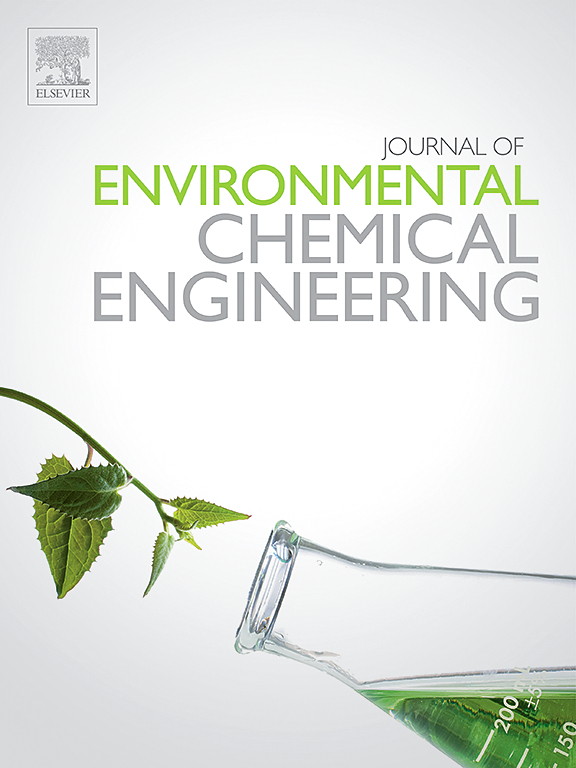Intensification of ozone mass transfer and hydroxyl radical generation in HC-UC/RF coupled system: Promotion and application
IF 7.4
2区 工程技术
Q1 ENGINEERING, CHEMICAL
引用次数: 0
Abstract
Advanced oxidation processes (AOPs) are widely used in water treatment, yet traditional ozone (O3)-based processes are limited by O3's low water solubility and mass transfer efficiency. This study established a coupled system that integrates hydrodynamic cavitation (HC), ultrasonic cavitation (UC), and rotational flow field (RF) to enhance ozonation. Considering O3 decomposition, this study investigated the effects of various operating factors on the mass transfer coefficients and generation of hydroxyl radicals (•OH). The results showed that the HC-UC/RF system overcame the limitations of the individual technologies. HC enhanced turbulence and generated microbubbles, improving the contact efficiency between O3 and the liquid phase. Meanwhile, the synergistic effect of rotational flow and UC optimized the distribution of cavitation bubbles within the reactor, thereby enhancing the cavitation effect. This coupled system significantly increased the generation of •OH and mass transfer efficiency of O3. Under the optimal conditions of 43.92 mg/L O3 concentration, 100 L/h O3 gas flow rate, 20 kHz ultrasonic frequency, and 600 W ultrasonic power, the yield of •OH was 0.2717 μmol/(L min), the decomposition rate constant of O3 was 0.5457 min−1, and the volumetric mass transfer coefficient was 0.1166 min−1. The degradation of tetracycline and norfloxacin was compared across different systems, further verifying the enhanced oxidizing capacity of the coupled system. Specifically, the HC-UC/RF system achieved rapid antibiotic degradation, with a 57 % TOC removal efficiency after 16 min. This study presents a novel hybrid system that offers additional insights into enhancing the efficiency of O3-based AOPs.
HC-UC/RF耦合系统中臭氧传质和羟基自由基生成的强化:推广与应用
高级氧化工艺(AOPs)在水处理中得到了广泛的应用,但传统的臭氧(O3)基工艺受到O3低水溶性和传质效率的限制。本研究建立了一种结合流体动力空化(HC)、超声空化(UC)和旋转流场(RF)的耦合系统来增强臭氧化。考虑O3的分解,本研究考察了不同操作因素对传质系数和羟基自由基(•OH)生成的影响。结果表明,HC-UC/RF系统克服了单个技术的局限性。HC增强了湍流,产生了微气泡,提高了O3与液相的接触效率。同时,旋流与UC的协同作用优化了反应器内空化泡的分布,从而增强了空化效果。该耦合体系显著提高了•OH的生成和O3的传质效率。在O3浓度43.92 mg/L、O3气体流速100 L/h、超声频率20 kHz、超声功率600 W的最佳条件下,•OH产率为0.2717 μmol/(L min), O3的分解速率常数为0.5457 min−1,体积传质系数为0.1166 min−1。比较了不同体系对四环素和诺氟沙星的降解效果,进一步验证了耦合体系对四环素和诺氟沙星的氧化能力。具体来说,HC-UC/RF系统实现了快速的抗生素降解,16 min后TOC去除率为57 %。该研究提出了一种新型混合系统,为提高基于臭氧的AOPs的效率提供了额外的见解。
本文章由计算机程序翻译,如有差异,请以英文原文为准。
求助全文
约1分钟内获得全文
求助全文
来源期刊

Journal of Environmental Chemical Engineering
Environmental Science-Pollution
CiteScore
11.40
自引率
6.50%
发文量
2017
审稿时长
27 days
期刊介绍:
The Journal of Environmental Chemical Engineering (JECE) serves as a platform for the dissemination of original and innovative research focusing on the advancement of environmentally-friendly, sustainable technologies. JECE emphasizes the transition towards a carbon-neutral circular economy and a self-sufficient bio-based economy. Topics covered include soil, water, wastewater, and air decontamination; pollution monitoring, prevention, and control; advanced analytics, sensors, impact and risk assessment methodologies in environmental chemical engineering; resource recovery (water, nutrients, materials, energy); industrial ecology; valorization of waste streams; waste management (including e-waste); climate-water-energy-food nexus; novel materials for environmental, chemical, and energy applications; sustainability and environmental safety; water digitalization, water data science, and machine learning; process integration and intensification; recent developments in green chemistry for synthesis, catalysis, and energy; and original research on contaminants of emerging concern, persistent chemicals, and priority substances, including microplastics, nanoplastics, nanomaterials, micropollutants, antimicrobial resistance genes, and emerging pathogens (viruses, bacteria, parasites) of environmental significance.
 求助内容:
求助内容: 应助结果提醒方式:
应助结果提醒方式:


